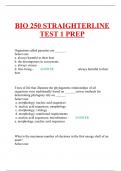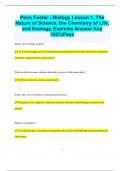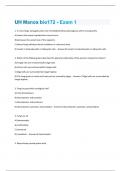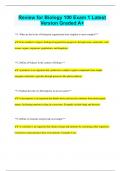Decomposers - Study guides, Class notes & Summaries
Looking for the best study guides, study notes and summaries about Decomposers? On this page you'll find 831 study documents about Decomposers.
Page 2 out of 831 results
Sort by

-
WSU Biology 106 exam 2 with Complete Solutions
- Exam (elaborations) • 19 pages • 2024
- Available in package deal
-
- $9.99
- + learn more
WSU Biology 106 exam 2 with Complete Solutions Fungi heterotrophs that feed by absorption Heterotrophs absorb nutrients from outside the body Roles of fungi decomposers, parasites, mutualists (symbiotic and microrizzae), early land colonizers What do fungi use to break complex molecules? Enzymes Chitin made of cellulose, make up the cell walls of fungi Hyphae continuous strands above/below ground, generate spores, colonizes soil Fungi life cycle Mycellum a collective...

-
Elementary OSAT Subtest 2 Questions and Answers Graded A+
- Exam (elaborations) • 21 pages • 2024
-
Available in package deal
-
- $9.99
- + learn more
Elementary OSAT Subtest 2 Questions and Answers Graded A+ What is the function of the digestive system in the human body? The function of the digestive system is to break down food, absorb nutrients, and eliminate waste. How does water cycle through the environment? Water cycles through the environment via processes like evaporation, condensation, precipitation, and runoff. What are the three states of matter? The three states of matter are solid, liquid, and gas. What i...

-
BIO 250 STRAIGHTERLINE TEST 1 PREP
- Exam (elaborations) • 38 pages • 2024
- Available in package deal
-
- $11.49
- + learn more
BIO 250 STRAIGHTERLINE TEST 1 PREP Organisms called parasites are ______. Select one: a. always harmful to their host b. the decomposers in ecosystems c. always viruses d. free-living - ANSWER always harmful to their host Trees of life that illustrate the phylogenetic relationships of all organisms were traditionally based on ______; newer methods for determining phylogeny rely on ______. Select one: a. morphology; nucleic acid sequences ...

-
Brooks Biodiversity Unit 2 Exam Questions and Answers
- Exam (elaborations) • 17 pages • 2024
-
Available in package deal
-
- $11.99
- + learn more
Brooks Biodiversity Unit 2 Exam Questions and AnswersBrooks Biodiversity Unit 2 Exam Questions and AnswersBrooks Biodiversity Unit 2 Exam Questions and AnswersBrooks Biodiversity Unit 2 Exam Questions and AnswersThe Primary role of Fungi - ANSWER-Decomposers- they break things down Modes of Nutrition in Fungi - ANSWER-Heterotrophs with extracellular digestion Exoenzymes - ANSWER-Fungi Release these enzymes outside of the cell wall. Break down complex molecules into smaller organic molecule...

-
BIOL 172L EXAM 1 UH MANOA QUESTIONS AND ANSWERS RATED A+
- Exam (elaborations) • 23 pages • 2024
-
Available in package deal
-
- $9.99
- + learn more
BIOL 172L EXAM 1 UH MANOA QUESTIONS AND ANSWERS RATED A+ **Endosymbiosis** Endosymbiosis is the process in which unicellular organisms engulf other cells, which then function as organelles within the host cell. This relationship is usually obligate, meaning the survival of one depends on the other. Studies of DNA sequencing suggest that green and red algae developed when heterotrophic eukaryotes engulfed cyanobacteria. **Algae** Algae are: - Eukaryotic - Aquatic - Photo-aut...

-
Biology 112 Exam 4-Marvin Latest Update Graded A+
- Exam (elaborations) • 18 pages • 2024
-
Available in package deal
-
- $9.99
- + learn more
Biology 112 Exam 4-Marvin Latest Update Graded A+ What process do plants use to convert sunlight into chemical energy? Plants use photosynthesis to convert sunlight into chemical energy in the form of glucose. How do herbivores obtain energy from plants? Herbivores obtain energy by consuming plant material, breaking it down in their digestive systems to extract nutrients. What role do decomposers play in an ecosystem? Decomposers break down dead organic matter, recycling nutrient...

-
Penn Foster - Biology Lesson 1, The Nature of Science, the Chemistry of Life, and Ecology, Exercise Answer Key 100%Pass
- Exam (elaborations) • 29 pages • 2024
-
Available in package deal
-
- $9.99
- + learn more
Penn Foster - Biology Lesson 1, The Nature of Science, the Chemistry of Life, and Ecology, Exercise Answer Key 100%Pass What is the scientific method? A systematic approach to investigating natural phenomena through observation, hypothesis formation, experimentation, and analysis. What are the four major elements that make up most of the human body? Carbon, hydrogen, oxygen, and nitrogen. What is the role of enzymes in biochemical reactions? Enzymes act as catalysts to spe...

-
UH Manoa bio172 - Exam 1 Questions And Answers Rated A+ New Update Assured Satisfaction
- Exam (elaborations) • 10 pages • 2024
- Available in package deal
-
- $7.99
- + learn more
1. In most fungi, karyogamy does not immediately follow plasmogamy, which consequently A) means that sexual reproduction cannot occur. B) decreases the overall size of the organism. C) allows fungi withstand harsh conditions in a dormant state. D) results in heterokaryotic or dikaryotic cells. - Answer-D) results in heterokaryotic or dikaryotic cells. 2. Which of the following best describes the physical relationship of the partners involved in lichens? A) Fungal cells are enclosed within ...

-
MCB2010 Exam 1 questions with complete solutions
- Exam (elaborations) • 24 pages • 2024
-
- $15.49
- + learn more
Microorganisms Correct Answer-organisms that are too small to be seen with the unaided eye Microbes in our life Correct Answer--pathogenic (disease-causing) -organic (carbon-based) (proteins, carbs, DNA) What do microbes produce? Correct Answer--produce industrial chemicals such as ethanol and acetone -produce fermented foods such as vinegar, cheese and bread -produce products in manufacturing (cellulase) and treatment (insulin) What are the 3 classifications in the ecosystem? Correc...

-
Review for Biology 100 Exam 1 Latest Version Graded A+
- Exam (elaborations) • 11 pages • 2024
-
- $9.99
- + learn more
Review for Biology 100 Exam 1 Latest Version Graded A+ **1. What are the levels of biological organization from simplest to most complex?** From smallest to largest, biological organization progresses through atoms, molecules, cells, tissues, organs, organisms, populations, and kingdoms. **2. Define a Producer in the context of biology.** A producer is an organism that synthesizes complex organic compounds from simple inorganic molecules, typically through processes like photosynt...

Study stress? For sellers on Stuvia, these are actually golden times. KA-CHING! Earn from your study resources too and start uploading now. Discover all about earning on Stuvia


